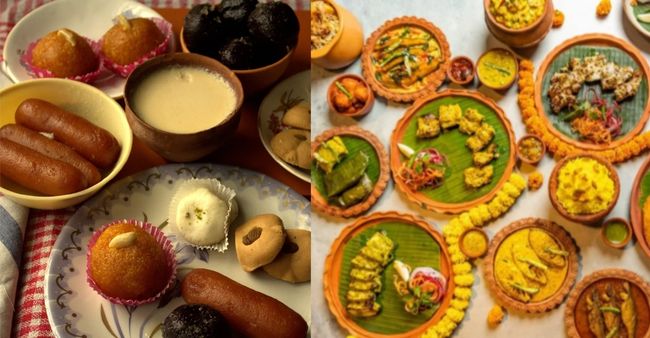It is the time of Durga Puja already and we can feel the excitement filled in the air, and hearts brimming with anticipation!
The festivities of Navratri and Durga Puja or Durga Pujo have a unique blend of devotion and food delights. Throughout these celebrations, we witness a devout and culturally rich communitycelebrating, sharing their experiences with traditional dishes and the enchanting sweetness of the occasion, all offered to Goddess Durga first.
All these festivities are marked incomplete without offering bhog to Goddess Durga.
A bhog is an offering to the deity which symbolizes the devotion and gratitude of the devotees. In the various Hindu scriptures, one of the most significant references can be found in the Devi Bhagavata Purana and the Chandipath describing the worship and offerings made to Goddess Durga during the nine-day festival of Navratri, which culminates in Durga Puja.
These texts provide guidelines on how offerings of various foods, including grains, fruits, and sweets, should be made to the goddess as a symbol of devotion. Additionally, there are various religious texts that mention the importance of offering pure and satvik(pure, clean) food to deities, which aligns with the preparation and presentation of bhogduring Durga Puja.
While there is a basic set of ingredients and processes, the beauty of bhoglies in its ability to adapt to diverse regional preferences and individual tastes.
The Key Ingredients used in making of bhog are: Rice, Pulses (such as moong dal or chana dal), Vegetables (potatoes, pumpkin, and eggplant), Spices (cumin, mustard seeds, turmeric, and red chili), Ghee, Sugar, Milk, Flour (wheat, rice flour or kuttu ka atta), and Dry Fruits.
There are various regional variations while making the bhog to offer Goddess Durga:
- West Bengal:People in West Bengalnotably makes Sandesh and Rasgulla for bhog. Moreover, the festival witnesses a mix of vegetarian and non-vegetarian offerings, reflecting the diversity of preferences.
- Assam:A distinctive bhog known as ‘Khar’ takes center stage in Assam. This alkaline preparation is made of raw papaya and pulses, setting it apart from other regional variations.
- Odisha:People here makes Khichdi and Dalma for the offerings.
- Bihar: ‘Thekua,’ a delectable sweet crafted from wheat flour or bajra, jaggery, and coconut can be seen offered during Durga Puja.
All these regional variations are always complemented with offering sweets in bhog to Goddess Durga. As the sun sets and the festivities continue, one can’t help the pull towards the delightful sweets that adorn the streets and homes. Whether it’s the tempting sandesh, melt-in-the-mouth rasgulla, or crispy jalebi, these sweets are integral part of the joyous celebration.
Sweets like Sandesh and Rosogolla represent a gesture of love and respect to the deity. The act of offering these sweets is a way to seek the goddess’s blessings and express gratitude. After the bhog is offered to the divine feminine energy, it becomes prasadam, consecrated food blessed by the Divine. Devotees believe that consuming prasadam during Durga Puja brings spiritual purification and positive energy into their lives.
Sandesh is a quintessential Bengali sweet made from fresh paneer or chhena. Its significance lies in its purity and simplicity. The use of chhena, which is essentially unaged cheese curd, signifies the use of unadulterated and natural ingredients, aligning with the concept of purity and devotion during Durga Puja. Sandesh is often molded into intricate shapes and garnished with slivers of pistachio or saffron, adding an artistic touch to its presentation. It symbolizes the offering of one’s best to the deity.
Rosogolla (or Rasgulla)is soft, spongy cheese ball soaked in sugar syrup. Its symbolic significance lies in its sweetness, which represents the sweetness of life and the divine blessings sought during Durga Puja. The syrupy nature of Rosogolla signifies the desire for a life filled with sweetness and joy. The soft, delicate texture of the sweet also mirrors the tender emotions of devotion.
Navratri and Durga Puja are more than just festivals; they are a beautiful blend of spirituality, culture, and culinary delights. Offering bhog to the devi is more than just a ritual.The bhogand a variety of sweets prepared during these celebrations provide a unique insight into the rich traditions and the warm hospitality of the people celebrating during this time.

